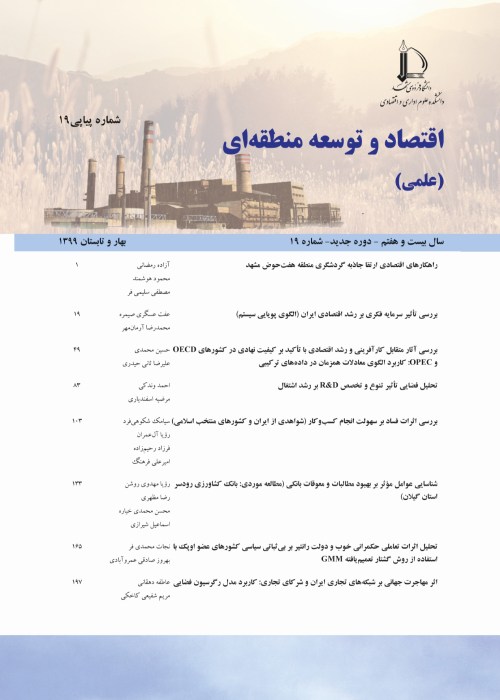Application of Multi-level Modeling in Analysis of Environmental Kuznets Curve: The Case of 33 Selected Countries of Four Income Groups
Author(s):
Abstract:
Introduction
A lot of activities in environmental economics scope have concentrated on this question that why some developing countries suffer from environmental degradation, whereas other countries can maintain or enhance the environmental quality. With the collapse of communism and economic evolution of China, most people live, work and bargain in free market economies. Hence, future quality of environment depends on the relationship between pollution and the growth of the free market. The principle cooperation of economists in investigation of this issue is related to Environmental Kuznets Curve (EKC) concept. In short, this hypothesis is based on the principle that economic development strengthens the environment and also weakens it. Economic development especially in poorer countries mostly results in decreasing environmental quality, but continuity of this trend can solve a lot of environmental related problem in countries with moderate and wealthier economy. On this base, the aim of this research is investigation of environmental Kuznets curve (EKC) in selected countries of four income groups of the world.THEORETICAL FRAMEWORK: The hypothesis of environmental Kuznets curve (EKC) assumes that there is not a monotone and constant relationship between per capita gross domestic product (GDP) and environmental quality. If environmental Kuznets curve hypothesis is true, per capita income trends will underestimate general changes in welfare in rich countries and overestimate them in poorer countries. A number of World Bank economists have argued that environmental Kuznets curve shifted to left and down during the time. If their conclusion is correct, then developing countries will be able to take advantage of this issue in two ways. First, probably they will reach their turning point earlier than other countries (which have reached their income turning point in the past). Second, before reaching the turning point, they suffer less environmental damage.
Methodology
In order to investigate environmental Kuznets curve hypothesis, present research has applied multilevel modeling which relaxes a lot of previous research deficits. Multilevel modeling helps more precise data analysis through maintaining categorized and hierarchical structure of data and in fact by using original data structure in analysis process relaxes the heteroscedasticity - which is resulted in due to integration of hierarchical structure of data- as much as possible. In this regard, present research by using time series data of 1991- 2009 for 33 selected countries in four income groups (high, higher than average, lower than average and low income) has investigated the relationship between CO2 emission and gross domestic product (GDP). Original data of real GDP (year 2000 dollar), population (in order to account per capita) and CO2 emission have been gathered from world development indices of World Bank.Results and Discussion
Results of this research indicate the necessity of applying multilevel modelling in evaluation of this hypothesis. Based on this model results EKC hypothesis would not be rejected and also high income countries have passed per capita GDP level of Kuznets Curve turning point and therefore they are in the descending part of this curve. Whereas, low and lower middle income countries are far away from per capita GDP of maximum pollution and until they do not use market and non-market forces, remain in the trap of pollution increase as a result of GDP increase. Based on these findings, higher than average income countries are able to reach this level, hardly.CONCLUSIONS & SUGGESTIONS: Taking into consideration of the real world and current situation of low and lower than average countries (from the aspects of technology, infrastructures and different political and economic structures, etc.) reaching to descending part of environmental Kuznets curve (EKC) is approximately impossible. In order to fulfill the part of descending pollution, it is necessary to make major changes in market and non-market forces of these countries. Price and technology are two of the market forces of this atmosphere. Prices are the most fundamental factor affecting on form and situation of EKC. Higher energy prices delay the economic development, but one of the advantages of higher energy prices is incentive to reduce consumption. Other forces affecting EKC atmosphere are non-market forces like government role. Government measurements like green (clean) technology help to explain both the form and situation of Kuznets curve. In addition, better information about environmental hazards can shift the curve through the need for rules and regulations in lower level of per capita income.
Keywords:
Language:
Persian
Published:
Journal of Economy and Regional Development, Volume:22 Issue: 10, 2016
Pages:
39 to 56
magiran.com/p1523206
دانلود و مطالعه متن این مقاله با یکی از روشهای زیر امکان پذیر است:
اشتراک شخصی
با عضویت و پرداخت آنلاین حق اشتراک یکساله به مبلغ 1,390,000ريال میتوانید 70 عنوان مطلب دانلود کنید!
اشتراک سازمانی
به کتابخانه دانشگاه یا محل کار خود پیشنهاد کنید تا اشتراک سازمانی این پایگاه را برای دسترسی نامحدود همه کاربران به متن مطالب تهیه نمایند!
توجه!
- حق عضویت دریافتی صرف حمایت از نشریات عضو و نگهداری، تکمیل و توسعه مگیران میشود.
- پرداخت حق اشتراک و دانلود مقالات اجازه بازنشر آن در سایر رسانههای چاپی و دیجیتال را به کاربر نمیدهد.
In order to view content subscription is required
Personal subscription
Subscribe magiran.com for 70 € euros via PayPal and download 70 articles during a year.
Organization subscription
Please contact us to subscribe your university or library for unlimited access!



